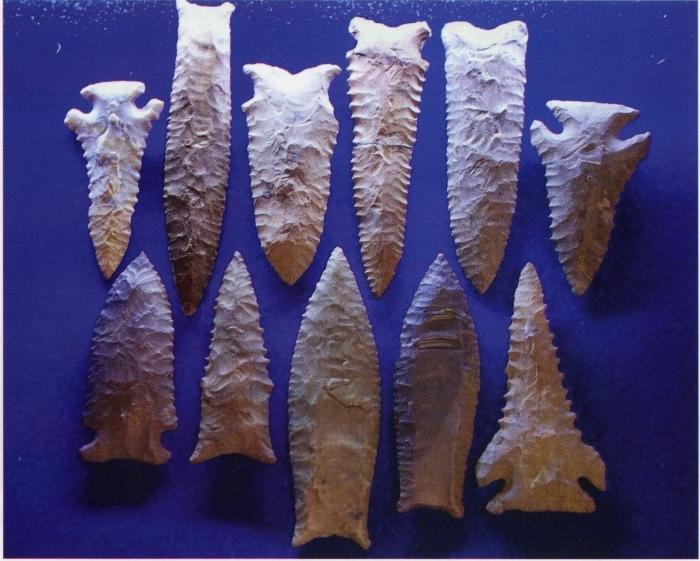by Greg L. Moore, DVM, Rhome, Texas
Originally Published in the Central States Archaeological Journal, Vol.56, No.4, pg.200Originally Published in the Central States Archaeological Journal, Vol.57, No.1, pg.37

Above: Projectile point tips showing flaking patterns. Notice the similarity amongst the various points. Can you identify any particular points from this picture? Which tips belong to an Archaic Point? Which belong to a Cumberland? Evidence has been recently presented to the archaeological community that perhaps the Cumberland Point predates the Clovis Point. While this article does not try to disprove this hypothesis, it does give a different perspective on point style similarities and perhaps reason to rethink the way we construct point chronology. See the full photo on the next page for the rest of the points.
This article presents nothing new and has been employed by both amateur and professional archaeologists for decades. Many knife and projectile point types have never been discovered in a datable context. When this occurs, these artifacts are often assigned assumptive or presumed time periods. Studying the flaking patterns to produce the preform or artifact and the reduction strategies employed as the artifact is utilized to replenish the blade edges, one can compare similar techniques found on artifacts from a dated context.
Of benefit in employing this method of dating is the relative “constant” that every specific type of knife or projectile of a “documented type” is manufactured and re-sharpened in a similar technique with relatively little variation. This suggests that specific artifact types had predetermined uses and hafting techniques employed by the people using them. Where variations do exist, most can be attributed to the differences in chosen lithic materials and the skill of the ancient knapper.
The pictures used in this article are simple yet represent the point ofthis article- the unique similarities in flaking and reduction techniques between Cumberland period artifacts and those of the early Archaic period including Heavy Duty, Greenbriar, Pine Tree, Colbert Dalton, Palmer and possibly, Harpeth River.
The Cumberland, in both its fluted and unfluted forms, was named for the Cumberland River Valley where it is predominately found and includes the states of Tennessee, Alabama, Kentucky, and Ohio. The early Archaic artifacts previously listed also appear to be concentrated in a similar geographical area and could suggest a possible relationship.
Although exact dates cannot be determined, to the author, it appears that the Cumberland artifacts may only marginally predate these early archaic types. Certainly it is possible that the early archaic types may have evolved directly from the Cumberland technology and some, such as the Heavy Duty for example, may have co-existed with the Cumberland but had other specific uses unknown to us at this time.


The complete picture from the top of the article “Flaking and Reduction Strategies as a Chronological Indicator In Cumberland and Early Archaic Artifacts”“Used by Permission of the Author”
To learn more about or to join the Central States Archaeological Society, click here:CSASI.org
